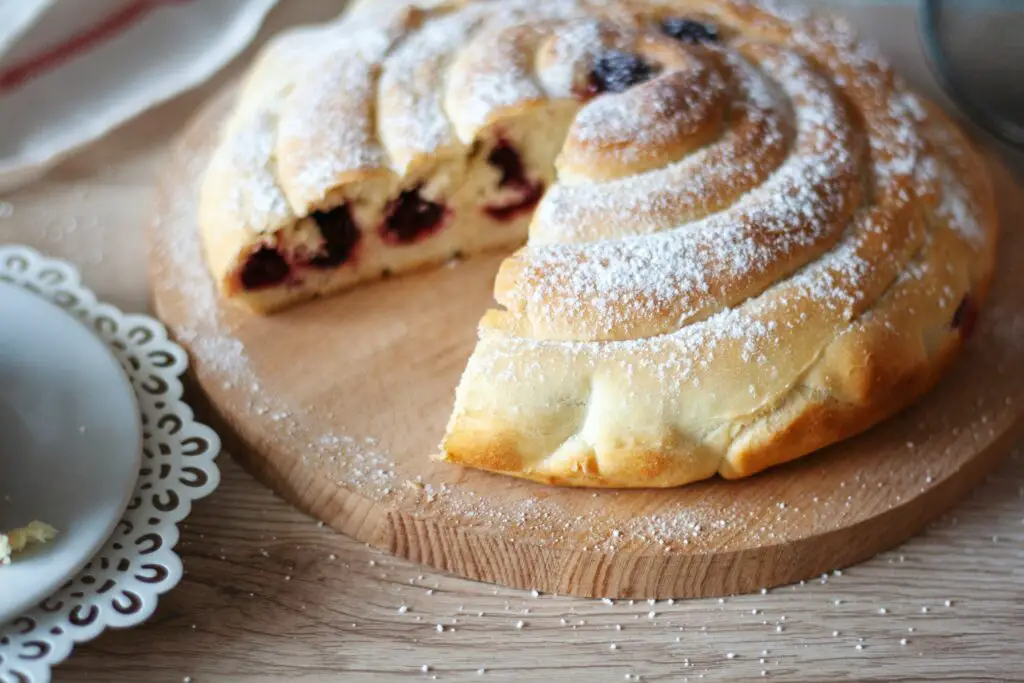Nothing crushes a baker’s spirit faster than pulling a pie from the oven only to find a soggy bottom or a crust that could double as shoe leather.
Pie baking is a funny mix of art and science—it’s part precision, part intuition, and just a dash of patience. The good news? Most pie fails come down to a handful of simple mistakes.
Learn to dodge them, and suddenly you’re the person everyone begs to bring dessert!
Mistake #1: Not Keeping Ingredients Cold
Why Cold Butter and Water Matter
The secret to a light, flaky pie crust lies in temperature control. Cold butter doesn’t fully blend into the flour—it breaks into little pockets instead.
When the crust bakes, those pockets of fat melt, releasing steam that creates thin, crispy layers. That’s the magic behind a crust that shatters delicately when you cut into it.
Warm butter, on the other hand, blends too much with the flour, and you end up with a dense, heavy shell.
What Happens When Ingredients Get Too Warm
If your butter softens before you even start rolling, the dough will feel greasy in your hands. That grease works against you, soaking into the flour and eliminating those precious air pockets.
The result? A crust that’s tough, chewy, and more likely to shrink in the pan. It’s the pie equivalent of biting into cardboard when you were expecting a croissant.
Quick Fix: Chill Everything
The fix is surprisingly simple—keep things cold. Cube your butter and stick it in the freezer for a few minutes before mixing. Use ice water instead of tap water.
Even your flour and mixing bowl can benefit from a quick chill in the fridge on a hot day.
If you ever feel the dough warming up while rolling, don’t push through. Pop it back in the fridge for ten minutes, then continue. A little patience here goes a long way in saving your crust.
Mistake #2: Overworking the Dough
What Happens When You Knead Too Much
Pie dough isn’t bread dough, and that’s where many bakers trip up. With bread, you want to knead to develop gluten for structure and chew. With pie, gluten is the enemy.
Too much handling causes those gluten strands to strengthen, and instead of tender, flaky layers, you get a crust that’s stiff and hard to bite through. Think “boot sole” instead of “buttery pastry.”
Signs You’ve Gone Too Far
The dough will usually warn you if you’re pushing it. If it feels rubbery instead of soft, you’ve worked it too much.
If the crust comes out of the oven hard enough to make you reach for a steak knife, that’s another giveaway.
You might also see shrinking edges, where the dough pulls away from the pie plate during baking. All of these are red flags that the gluten had too much of a workout.
Solution: Mix Just Until It Comes Together
The good news? You don’t need to be a perfectionist. The goal is to combine your ingredients until they just form a dough. It’s okay—even preferable—if you still see little specks of butter in the mix.
Those specks are what create the flakiness later. A simple trick: stop mixing the moment the dough holds its shape when pressed. If in doubt, err on the side of under-mixing. The oven will take care of the rest.
Mistake #3: Skipping Blind Baking
Why Some Pies Need a Head Start
Not all pies bake the same way. Custard pies, cream pies, and even certain fruit pies need a crust that’s already partially baked before the filling goes in.
This step, called blind baking, gives the crust a head start so it has time to crisp up. Without it, the crust has to battle a wet filling from the beginning, and nine times out of ten, it loses.
The Soggy Bottom Disaster
Nothing ruins a pie faster than slicing into it and finding the dreaded soggy bottom. Instead of a crisp, golden base that holds up the filling, you’re left with a mushy layer that tastes more like raw dough than pie.
It’s disappointing and messy, like eating a sandwich where the bread has been sitting in soup. That’s what happens when blind baking is skipped—it’s the difference between a sturdy foundation and a sinking ship.
The Simple Fix: Pie Weights (or Beans)
The solution is straightforward. Line your crust with parchment or foil, then fill it with pie weights, dried beans, or even rice. This keeps the dough from puffing up while it par-bakes in the oven.
Once the crust is lightly golden, remove the weights and finish baking it for a few more minutes.
The result? A crisp, ready-to-fill shell that won’t buckle under custard, cream, or fruit juices. It’s like giving your pie a strong backbone before sending it into battle.
Mistake #4: Using the Wrong Apples (or Fruit)
When Fruit Turns Mushy or Watery
Fruit is the star of many pies, but not all fruit knows how to perform under oven lights. Some apples collapse into applesauce when baked, while others release so much juice that your pie practically becomes soup.
The same goes for berries and peaches—choose the wrong type, and you’ll end up with a runny filling and a crust that’s drowning.
Why Firm, Tart Apples Are Best
Firm apples, like Granny Smith and Honeycrisp, hold their shape during baking. They soften just enough to be tender but still give you that satisfying bite.
Tartness also matters because it balances the sweetness of sugar and spices. Without that contrast, a pie can taste flat, like eating a spoonful of jam. A good pie should make your taste buds dance, not nap.
Bonus Tip: Mix Varieties for Balance
One apple rarely does it all. That’s why many bakers mix varieties—say, a Granny Smith for structure and a Honeycrisp or Fuji for sweetness.
The combination creates depth of flavor and the perfect balance of juicy and firm. It’s like assembling a band: one instrument might carry the tune, but the harmony only comes when they all play together.
For fruit pies beyond apples, the same rule applies—look for a mix of firm and juicy to keep both flavor and texture in check.
Mistake #5: Forgetting to Vent or Lattice
Why Steam Release Is Critical
Fruit pies are loaded with natural juices. As they bake, those juices bubble and release steam. If that steam has no escape route, it builds up under the crust.
The pressure can cause cracks, leaks, or worse—the dreaded pie eruption where filling boils out the sides.
A few simple vents in the top crust act like little chimneys, letting steam out without letting flavor escape.
What Happens If You Skip It
Skip venting, and you’re asking for trouble. The filling stays trapped, and instead of thickening as it bakes, it turns soupy. You cut into your pie, and suddenly it’s more like a fruit stew.
The top crust might also crack in random places as the steam forces its way out, leaving you with a pie that looks like it lost a bar fight.
The Easy Fix: Slits, Lattice, or Crumbs
The solution is both practical and pretty. Cut a few slits in the top crust with a sharp knife—it doesn’t take much.
If you want a showstopper, try a lattice crust that naturally allows steam to escape while looking Instagram-worthy.
Crumb toppings work too, giving your pie texture and crunch without trapping the filling. Venting isn’t just about function; it’s a chance to add personality to your pie.
Mistake #6: Cutting Too Soon
The Temptation vs. Reality
The hardest part of pie baking isn’t mixing the dough or rolling it out—it’s waiting once it’s done.
That golden, bubbling beauty comes out of the oven, and every fiber of your being screams, “Cut me a slice now!” But here’s the truth: pies are like toddlers after a sugar rush.
They need time to settle down before you can handle them.
What Happens When You Cut Too Early
If you dive in while the pie is still hot, the filling hasn’t had time to thicken. All that lovely fruit or custard will spill out, leaving you with a puddle on the plate instead of neat slices.
Your crust, which worked so hard to stay crisp, ends up soggy as it soaks in the runoff. It’s heartbreaking—like building a sandcastle just to watch the tide take it out.
The Simple Fix: Patience Pays Off
The fix is frustrating but foolproof: wait. Most pies need at least 2–4 hours to cool and set properly. Custard and cream pies may need even longer, sometimes a full chill in the fridge.
If you want tidy, bakery-worthy slices, let the pie rest. Think of it as delayed gratification—the flavor actually improves as it cools, and you’ll be rewarded with clean cuts and a filling that holds together.
Mistake #7: Ignoring Oven Temperature
Why Temperature Matters
Your oven is the boss of the pie. Too hot, and it bullies the crust into burning before the filling cooks. Too cool, and you’ll end up with a pale crust and a soggy bottom that never firms up.
Pie baking is all about balance, and the right temperature makes sure both crust and filling finish together in perfect harmony.
The Risks of Going Too Low or Too High
Bake at a low temp, and the crust sits there steaming in its own juices instead of crisping up. The bottom stays gummy, and the filling often turns watery.
Crank it too high, and the top looks done while the inside is still raw. You’ll slice into it only to find cold fruit or runny custard. It’s the culinary equivalent of a pie with stage fright—great costume, no performance.
The Simple Fix: Trust but Verify
The fix is twofold. Always preheat your oven fully before sliding in the pie. Don’t rush it. An oven thermometer is also a small but mighty investment.
Many ovens run hotter or cooler than the dial suggests, and that little gadget tells you the truth. With the right heat, your pie will bake evenly—crust golden, filling set, and no surprises when you cut the first slice.
Final Words
Pie baking doesn’t have to be intimidating. Small changes like chilling your butter or waiting before slicing can turn frustration into flaky, golden success.
Mistakes happen, but they’re just stepping stones to better pies. So don’t fear them, learn from them.
Next time you bake, put these tips to the test and see the difference for yourself.
Try them out in your next pie bake-off and share the results—you might surprise yourself with how pro your pies look (and taste).
FAQs
Can I make pie dough ahead of time?
Yes! Pie dough actually benefits from resting in the fridge. You can make it up to 3 days in advance or freeze it for a few months. Resting helps relax the gluten, which makes rolling easier and prevents shrinking.
How do I prevent a soggy bottom?
Blind baking is your best friend here. You can also brush the crust with a light egg wash before filling to create a moisture barrier.
And always bake in a fully preheated oven, ideally with the pie placed on the lower rack for extra bottom heat.
Is butter better than shortening?
Butter gives the crust more flavor and flakiness, while shortening provides tenderness and stability. Many bakers use a mix of both to get the best of both worlds. If you’re after rich taste, butter usually wins the day.
Can I freeze pie dough?
Absolutely. Wrap it tightly in plastic wrap, then seal it in a freezer bag. It’ll keep for 2–3 months. Just thaw it overnight in the fridge before rolling it out.
Why does my crust shrink in the oven?
Usually, it’s from overworking the dough or not letting it rest. Gluten gets tight and pulls the crust back as it bakes.
To avoid this, let the dough chill before rolling, and once it’s in the pan, let it rest in the fridge again before baking.



